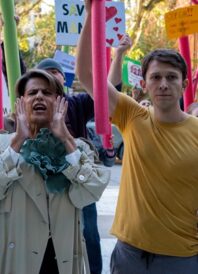
To Nabil Gamel (Ryan Ali), home can mean a literal one and one that he chooses for himself. The first one is cold and grey, a condo he’s temporarily staying in after moving from Cairo. And because he’s dealing with Toronto real estate, that condo actually belongs to his father Iskander (Dani Jazzar).
Nabil’s second home is one where he fits in more, which happens to be a Church Village drag bar. In Mandy’s, people of all genders perform and practically live, doing so even if the threat of gentrification looms. One of the people feeling that threat of gentrification is activist and transwoman Malibu (Alexandra Billings).
There’s more to the story in Reem Morsi’s Queen Tut that I’ll get to later, but for now I’ll say that this is the kind of film where off screen characters matter. The off screen character in question here is Nabil’s deceased seamstress mother, Selma, whose lack of guidance leaves him unmoored and unable to be himself.
Maybe between the first and the second acts, Nabil chooses not to go with fellow quasi-closeted Coptic Egyptian Marcos to Flash, which is apparently a night club now. Either Queen Tut is getting a lot of things wrong in the Village or I need to come back. Anyway, instead, he slow dances with some young lady he’ll never see again.
Despite Nabil’s efforts to forget, there are the reminders in Queen Tut that his second home is better than his first. Here, he goes to Malibu and gives her one of Selma’s designs, asking her to teach him how to make it, because baby drag requires baby steps. First the sewing, then the protests. Many queens skip both.
Malibu, then, teaches Nabil other things like being himself, a thing he can’t do yet. That may be one of the things that may fray their relationship. What may also destroy Nabil and Malibu’s relationship is Iskandar. Iskandar wants him to be a good son, but is also the developer trying to demolish Mandy’s.
My big issue in Queen Tut is that it idealises the village and its community as left wing idealists. Although yes, there is that scene where Malibu finds that half of her generation of 2LGBT+ people are sadly pro-condo. Despite this though, the film beautifully depicts what it’s like to belong to two communities.
There are a lot of great scenes in Queen Tut that depict both of Nabil’s communities. Its job is to depict the 2LGBT+ community, but it also depicts the Coptic community with dimension. Performances by Malibu and drag king Ryan (Kiriana Stanton) are for the books. But we can say the same for when Nabil ends a prayer with a four letter word. He ate, most of the 2LGBTs here do.
- Rated: NR
- Genre: Comedy, Drama
- Release Date: 2/23/2024
- Directed by: Reem Morsi
- Starring: Alexandra Billings, Dani Jazzar, Kiriana Stanton, Ryan Ali
- Produced by: Lauren Saarimaki, Lindsay Blair Goeldner, Shant Joshi
- Written by: Abdul Malik, Bryan Mark, Kaveh Mohebbi
- Studio: Fae Pictures, Hawkeye Pictures Inc., Ontario Creates, pUNK FILMS, Téléfilm Canada

